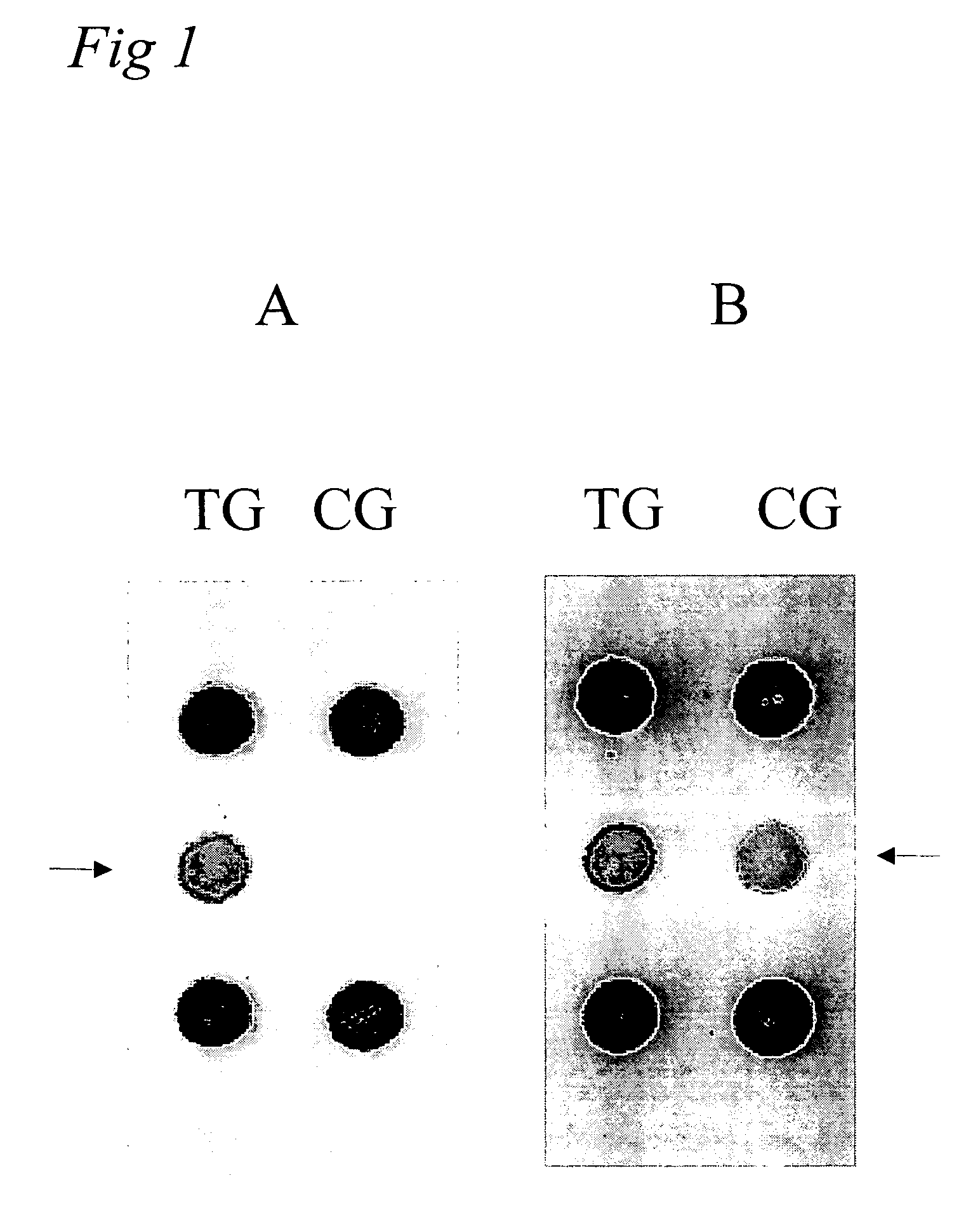Method and nucleic acids for the analysis of colon cancer
a nucleic acid and colon cancer technology, applied in the field of colon cancer methods and nucleic acids for analysis, can solve the problems of unable to analyze cells for thousands of possible methylation events, unable to carry out pcr amplification, and completely lose the epigenetic information carried by 5-methylcytosine during pcr amplification,
- Summary
- Abstract
- Description
- Claims
- Application Information
AI Technical Summary
Benefits of technology
Problems solved by technology
Method used
Image
Examples
example 1
Description of PCR
[0087] The single gene PCR reaction was performed using a thermocycler (Epperdorf GmbH) using 10 ng of bisulfite treated DNA, 6 pmole of each primer, 200 .mu.M of each dNTP, 1.5 mM MgCl.sub.2 and 1 U of HotstartTaq (Qiagen AG). The other conditions were as recommended by the Taq polymerase manufacturer. Single genes were amplified by PCR performing a first denaturation step for 14 min at 96.degree. C., followed by 39 cycles (60 sec at 96.degree. C., 45 sec at 55.degree. C. 75 sec at 72.degree. C.) and a subsequent final elongation of 10 min at 72.degree. C. The bisulfite DNA was prepared according to a published procedure from genomic DNA individually isolated from 12 matched samples of adenocarzinoma of the colon and healthy colon tissue. The genomic DNA was isolated using the wizzard DNA isolation kit (Promega, Madison).
example 2
Methylation Analysis of Gene p16
[0088] The following example relates to a fragment of the gene p16 in which a specific CG dinucleotide is to be analyzed for methylation.
[0089] In the first step, a genomic sequence is treated using bisulfite (hydrogen sulfite, disulfite) in such a manner that all cytosines which are not methylated at the 5-position of the base are modified in such a manner that a different base is substituted with regard to the base pairing behavior while the cytosines methylated at the 5-position remain unchanged.
[0090] If bisulfite solution is used for the reaction, then an addition takes place at the non-methylated cytosine bases. Moreover, a denaturating reagent or solvent as well as a radical interceptor must be present. A subsequent alkaline hydrolysis then gives rise to the conversion of non-methylated cytosine nucleobases to uracil. The chemically converted DNA is then used for the detection of methylated cytosines. In the second method step, the treated DNA ...
example 3
Differentiation Between Colon Tumour and Healthy Colon Tissue
[0093] Differentiation of healthy samples and adenocarzinoma tumours. For tumour class prediction between healthy and tumor tissue we used a Support Vector Machine (SVM) on a set of selected CpG sites (F. Model, P. Adorjan, A. Olek, C. Piepenbrock, Feature selection for DNA methylation based cancer classification. Bioinformatics. 2001 June;17 Suppl 1:S157-64.). First we ranked the CpG sites for a given separation task by their significance of the difference between the two class means. The significance of each CpG was estimated by a two sample t-test (W, Mendenhall, T, Sincich, Statistics for engineering and the sciences (Prentice-Hall, New Jersey 1995).
[0094] In order to relate the methylation patterns to a adenocarcinoma tumour, it is initially required to comparatively analyze the DNA methylation patterns of healthy tissue and adenocarzinoma tumours tissue (FIGS. 2A and B). These analyses were carried out, analogously t...
PUM
| Property | Measurement | Unit |
|---|---|---|
| Length | aaaaa | aaaaa |
| Mass | aaaaa | aaaaa |
| Electrical resistance | aaaaa | aaaaa |
Abstract
Description
Claims
Application Information
 Login to View More
Login to View More - R&D
- Intellectual Property
- Life Sciences
- Materials
- Tech Scout
- Unparalleled Data Quality
- Higher Quality Content
- 60% Fewer Hallucinations
Browse by: Latest US Patents, China's latest patents, Technical Efficacy Thesaurus, Application Domain, Technology Topic, Popular Technical Reports.
© 2025 PatSnap. All rights reserved.Legal|Privacy policy|Modern Slavery Act Transparency Statement|Sitemap|About US| Contact US: help@patsnap.com


